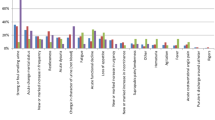Abstract
Introduction and hypothesis
A dipstick test is recommended to screen for urinary tract infection in patients with overactive bladder (OAB). It was the aim of this study to test if a dipstick test is sufficient to identify patients with urinary tract infection attending a urological private practice because of OAB.
Methods
All patients who attended the practice because of OAB symptoms were routinely catheterized; a urine specimen was tested with dipstick, the spun sediment was examined microscopically, and the specimen was sent for microbiological examination.
Results
Two thousand two hundred fifty-two patients were examined. Of 1,754 patients with negative dipstick screening, 353 patients (20.1%) had growth of ≥103 colony forming units. The dipstick test had a sensitivity of 0.442 and a specificity of 0.865 for the correct identification of urinary tract infection.
Conclusions
Dipstick screening is not sufficient to identify patients with urinary tract infection and symptoms of OAB.
Similar content being viewed by others
Abbreviations
- OAB:
-
Overactive bladder
- CFU:
-
Colony forming units
- UTI:
-
Urinary tract infection
References
Abrams P, Cardozo L, Fall M, Griffiths DJ et al (2002) The standardisation of terminology of lower urinary tract function. Neurourol Urodyn 21:167–178
Stewart WF, Van Rooyen JB, Cundiff GW, Abrams P et al (2003) Prevalence and burden of overactive bladder in the United States. World J Urol 20:327–336
Staskin D, Hilton P, Emmanuel A et al (2005) Initial assessment of incontinence. In: Abrams P, Cardozo L, Khoury S, Wein A (eds) Incontinence. 3rd International Consultation on Incontinence. Health, Plymouth, pp 485–518
Clinical and Laboratory Standards Institute (2009) Performance standards for antimicrobial susceptibility testing: 19th informational supplement. CLSI document M100-S19, 19th edn. Clinical and Laboratory Standards Institute, Wayne
Altman DG, Bland JM (1994) Diagnostic tests 2: predictive values. BMJ 309:102
Mitteness LS, Barker JC (1995) Stigmatizing a “normal” condition: urinary incontinence in late life. Med Anthropol Q 9:188–210
Ward KL, Hilton P, Browning J, on behalf of the UK and Ireland TVT Trial Group (2000) A randomized trial of colposuspension and tension-free vaginal tape (TVT) for primary genuine stress incontinence. Neurourol Urodyn 20:386–389
Reeves P, Irwin D, Kelleher C, Milsom I et al (2006) The current and future burden and cost of overactive bladder in five European countries. Eur Urol 50:1050–1057
Buchsbaum GM, Albushies DT, Guzick DS (2004) Utility of urine reagent strip in screening women with incontinence for urinary tract infection. Int Urogynecol J Pelvic Floor Dysfunct 15:391–393
Sultana RV, Zalstein S, Cameron P, Campbell D (2001) Dipstick urinalysis and the accuracy of the clinical diagnosis of urinary tract infection. J Emerg Med 20:13–19
Al Daghistani HI, Abdel-Dayem M (2002) Diagnostic value of various urine tests in the Jordanian population with urinary tract infection. Clin Chem Lab Med 40:1048–1051
Semeniuk H, Church D (1999) Evaluation of the leukocyte esterase and nitrite urine dipstick screening tests for detection of bacteriuria in women with suspected uncomplicated urinary tract infections. J Clin Microbiol 37:3051–3052
Gerber CS, Brendler CB (2002) Evaluation of the urologic patient: history, physical examination, and urinalysis. In: Campbell MF, Walsh PC, Retik AB (eds) Campbell’s Urology, 8th edn. Saunders, Philadelphia, pp 83–110
National Institute for Health and Clinical Excellence (2006) Urinary incontinence: the management of urinary incontinence in women. NICE Guideline CG40
Conflicts of interest
None.
Author information
Authors and Affiliations
Corresponding author
Rights and permissions
About this article
Cite this article
Hessdoerfer, E., Jundt, K. & Peschers, U. Is a dipstick test sufficient to exclude urinary tract infection in women with overactive bladder?. Int Urogynecol J 22, 229–232 (2011). https://doi.org/10.1007/s00192-010-1263-5
Received:
Accepted:
Published:
Issue Date:
DOI: https://doi.org/10.1007/s00192-010-1263-5




